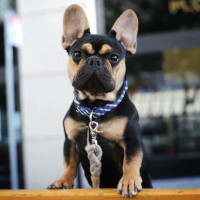Appearance of the French Bullweiler
|
| The mixing of two pure breeds can produce a litter with similarities in appearance to both breeds. Sometimes, a certain trait from one of the parents will be passed on to the litter. Many French Bullweiler puppies have the facial markings of the Rottweiler breed. The markings are on the eyes, cheeks and either side of the muzzle. There may also be tan markings on the chest, lower legs and under the tail. The French Bullweiler will have a short, dense coat. The hybrid may be medium to large and shorter than the Rottweiler, and its body will be robust and muscular. The head will be broad and square, and the French Bullweiler may have floppy or pricked ears. The tail can be long like that of the Rottweiler or short like that of the French Bulldog. Most Rottweilers you see have short tails because they have been docked. However, Rottweiler tails are naturally long. |
Temperament of the French Bullweiler
|
| The French Bullweiler will have the behavior and personality traits of both its parents. Even among the same littermates, you may notice different appearances and habits. Your hybrid will be highly intelligent and loyal. It's important that your French Bullweiler puppy is socialized from an early age. Obedience training is also recommended when he's young. Because he can be a little stubborn, consistency and patience will be necessary. Be a leader for your French Bullweiler and he should excel in his classes. The Rottweiler can be territorial and aggressive towards dogs, while the French Bulldog side can make him a clown. Your French Bullweiler will be happiest if he gets plenty of attention and love from you. Don't leave him alone for long periods, as he may start behaving anxiously, chewing furniture or barking excessively. |
Needs and activities of the French Bullweiler
|
| Your French Bullweiler may have moderate to high energy levels. It's important to take him for daily walks where he has the opportunity to sniff and explore. Don't rush him, take your time and let him enjoy your company. He'll love playing fetch and running in a fenced-in yard. Your French Bullweiler will also enjoy visiting a dog park, which will help him socialize with other dogs. French Bulldogs and Rottweilers don't do well in hot weather, so your French Bullweiler shouldn't be exposed to extreme temperatures. During the summer months, he should be walked in shady streets, ideally during the coolest hours of the day. |
Maintenance of the French Bullweiler
|
| The French Bullweiler has a short, dense coat that only needs combing and brushing once a week to remove loose hairs. If necessary, they can be bathed with a mild dog shampoo. His Rottweiler side can make him shed a lot. If your French Bullweiler has floppy ears, he'll need weekly ear cleaning to remove dirt. Excess moisture can be a problem, so make sure the ear is dry at all times. Your hybrid's teeth should be brushed a few times a week, and a visit to the dentist is recommended every year to ensure that the hygiene routine you've put in place is sufficient. Your French Bullweiler's nails shouldn't be neglected, so check them for breaks or tears after exercise and trim them if necessary. |









 English (United Kingdom)
English (United Kingdom)